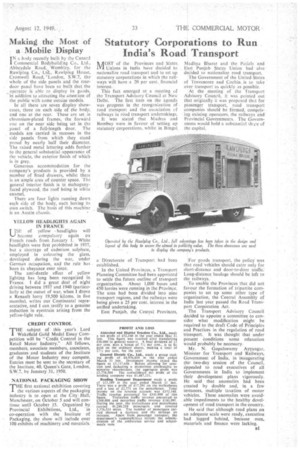/TOST of the Provinces and States, 1V1 Unions in India
Page 35

If you've noticed an error in this article please click here to report it so we can fix it.
have decided to nationalize road transport and to set up statutory corporations in which the railways -will have a 20 per cent.. financial interest..
This fact emerged at a meeting of the Transport Advisory Council at New Delhi. The first item on the agenda was progress in the reorganization of road transport and -the association of railways in road transport 'undertakings.
It was stated that Madras and Bombay were in favour of setting up statutory corporations, whilst in Bengal a Directorate of Transport had been established.
In the United Provinces, a Transport Planning Committee had been appointed to settle the. future outline of transport organization. About 1,000 buses arid 450 lorries Were running in the Province. The area had been divided into nine transport regions, and the railways were being given a 25 per cent. interest in the unified undertaking.
East Punjab, the Central Provinces,
Madhya Bharat and the Patiala and E.11:St PunjabStates Union had also • decided to nationalize road transport.
The Government of the United States of Travancore and Cochin, is to take over transport' as quickly as possible.
At the meeting of ,the Transport Advisory Council, it was -pointed out that originally it was proposed that for passenger transport, Toad transport companies should be formed, comprising existing operators, the railways an Provincial Governments.. The Governments would hold a substantial she of the capital.
For goods transport, the policy was that road.vehicles should cater only for short-distance and door-to-door trafficLong-distance haulage should be left to the railways.
To enable the Provinces that did not favour the formation of tripartite companies to set up some other type of organization, the Central Assembly of India last year passed the Road Transport Corporation Act.
The Transport Advisory Council decided to appoint a committee to consider what modification might be required to the draft Code of Principles and Practices in the regulation of road transport., It was thought that under present conditions some relaxation would probably be necessary.
Mr. N. Gopalswamy Ayyangar, Minister for Transport and Railways, Government of India, in inaugurating the two-day session of the Council, appealed to road executives of all Governments in India to implement their development plans vigorously. He said that anomalies had been created by double and, in a few instances, multiple taxation of motor vehicles. These anomalies were avoidable impediments to the healthy development of road transport in the country.
He said that although road plans on an adequate scale were ready, execution had lagged behind, because men, materials and finance were lacking.




















































































